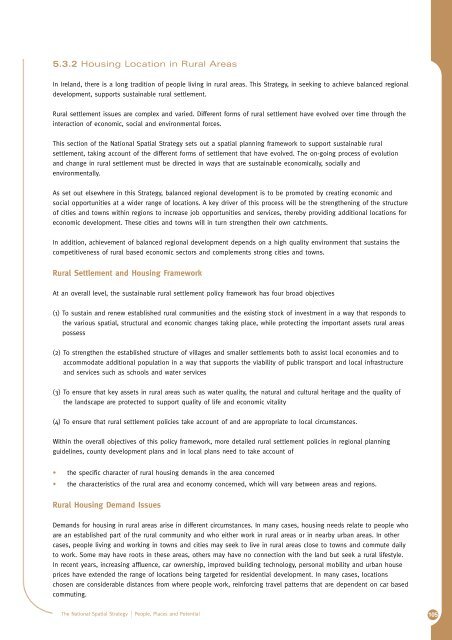National Spatial Strategy For Ireland 2002 - 2020 - Full ... - Kildare.ie
National Spatial Strategy For Ireland 2002 - 2020 - Full ... - Kildare.ie
National Spatial Strategy For Ireland 2002 - 2020 - Full ... - Kildare.ie
You also want an ePaper? Increase the reach of your titles
YUMPU automatically turns print PDFs into web optimized ePapers that Google loves.
5.3.2 Housing Location in Rural Areas<br />
In <strong>Ireland</strong>, there is a long tradition of people living in rural areas. This <strong>Strategy</strong>, in seeking to ach<strong>ie</strong>ve balanced regional<br />
development, supports sustainable rural settlement.<br />
Rural settlement issues are complex and var<strong>ie</strong>d. Different forms of rural settlement have evolved over time through the<br />
interaction of economic, social and environmental forces.<br />
This section of the <strong>National</strong> <strong>Spatial</strong> <strong>Strategy</strong> sets out a spatial planning framework to support sustainable rural<br />
settlement, taking account of the different forms of settlement that have evolved. The on-going process of evolution<br />
and change in rural settlement must be directed in ways that are sustainable economically, socially and<br />
environmentally.<br />
As set out elsewhere in this <strong>Strategy</strong>, balanced regional development is to be promoted by creating economic and<br />
social opportunit<strong>ie</strong>s at a wider range of locations. A key driver of this process will be the strengthening of the structure<br />
of cit<strong>ie</strong>s and towns within regions to increase job opportunit<strong>ie</strong>s and services, thereby providing additional locations for<br />
economic development. These cit<strong>ie</strong>s and towns will in turn strengthen their own catchments.<br />
In addition, ach<strong>ie</strong>vement of balanced regional development depends on a high quality environment that sustains the<br />
competitiveness of rural based economic sectors and complements strong cit<strong>ie</strong>s and towns.<br />
Rural Settlement and Housing Framework<br />
At an overall level, the sustainable rural settlement policy framework has four broad objectives<br />
(1) To sustain and renew established rural communit<strong>ie</strong>s and the existing stock of investment in a way that responds to<br />
the various spatial, structural and economic changes taking place, while protecting the important assets rural areas<br />
possess<br />
(2) To strengthen the established structure of villages and smaller settlements both to assist local econom<strong>ie</strong>s and to<br />
accommodate additional population in a way that supports the viability of public transport and local infrastructure<br />
and services such as schools and water services<br />
(3) To ensure that key assets in rural areas such as water quality, the natural and cultural heritage and the quality of<br />
the landscape are protected to support quality of life and economic vitality<br />
(4) To ensure that rural settlement polic<strong>ie</strong>s take account of and are appropriate to local circumstances.<br />
Within the overall objectives of this policy framework, more detailed rural settlement polic<strong>ie</strong>s in regional planning<br />
guidelines, county development plans and in local plans need to take account of<br />
• the specific character of rural housing demands in the area concerned<br />
• the characteristics of the rural area and economy concerned, which will vary between areas and regions.<br />
Rural Housing Demand Issues<br />
Demands for housing in rural areas arise in different circumstances. In many cases, housing needs relate to people who<br />
are an established part of the rural community and who either work in rural areas or in nearby urban areas. In other<br />
cases, people living and working in towns and cit<strong>ie</strong>s may seek to live in rural areas close to towns and commute daily<br />
to work. Some may have roots in these areas, others may have no connection with the land but seek a rural lifestyle.<br />
In recent years, increasing affluence, car ownership, improved building technology, personal mobility and urban house<br />
prices have extended the range of locations being targeted for residential development. In many cases, locations<br />
chosen are considerable distances from where people work, reinforcing travel patterns that are dependent on car based<br />
commuting.<br />
The <strong>National</strong> <strong>Spatial</strong> <strong>Strategy</strong> | People, Places and Potential<br />
105
















